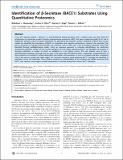| dc.contributor.author | Elias, Joshua E. | |
| dc.contributor.author | Maas, Stefan | |
| dc.contributor.author | Gygi, Steven P. | |
| dc.contributor.author | Selkoe, Dennis J. | |
| dc.contributor.author | Hemming, Matthew Louis | |
| dc.date.accessioned | 2012-03-01T01:35:47Z | |
| dc.date.issued | 2009 | |
| dc.identifier.citation | Hemming, Matthew L., Joshua E. Elias, Steven P. Gygi, and Dennis J. Selkoe. 2009. Identification of β-Secretase (BACE1) substrates using quantitative proteomics. PLoS ONE 4(12): e8477. | en_US |
| dc.identifier.issn | 1932-6203 | en_US |
| dc.identifier.uri | http://nrs.harvard.edu/urn-3:HUL.InstRepos:8296053 | |
| dc.description.abstract | β-site APP cleaving enzyme 1 (BACE1) is a transmembrane aspartyl protease with a lumenal active site that sheds the ectodomains of membrane proteins through juxtamembrane proteolysis. BACE1 has been studied principally for its role in Alzheimer's disease as the β-secretase responsible for generating the amyloid-β protein. Emerging evidence from mouse models has identified the importance of BACE1 in myelination and cognitive performance. However, the substrates that BACE1 processes to regulate these functions are unknown, and to date only a few β-secretase substrates have been identified through candidate-based studies. Using an unbiased approach to substrate identification, we performed quantitative proteomic analysis of two human epithelial cell lines stably expressing BACE1 and identified 68 putative β-secretase substrates, a number of which we validated in a cell culture system. The vast majority were of type I transmembrane topology, although one was type II and three were GPI-linked proteins. Intriguingly, a preponderance of these proteins are involved in contact-dependent intercellular communication or serve as receptors and have recognized roles in the nervous system and other organs. No consistent sequence motif predicting BACE1 cleavage was identified in substrates versus non-substrates. These findings expand our understanding of the proteins and cellular processes that BACE1 may regulate, and suggest possible mechanisms of toxicity arising from chronic BACE1 inhibition. | en_US |
| dc.language.iso | en_US | en_US |
| dc.publisher | Public Library of Science | en_US |
| dc.relation.isversionof | doi: 10.1371/journal.pone.0008477 | en_US |
| dc.relation.hasversion | http://www.ncbi.nlm.nih.gov/pmc/articles/PMC2793532/pdf/ | en_US |
| dash.license | LAA | |
| dc.title | Identification of β-Secretase (BACE1) Substrates Using Quantitative Proteomics | en_US |
| dc.type | Journal Article | en_US |
| dc.description.version | Version of Record | en_US |
| dc.relation.journal | PLoS ONE | en_US |
| dash.depositing.author | Gygi, Steven P. | |
| dc.date.available | 2012-03-01T01:35:47Z | |
| dash.affiliation.other | HMS^Stipendees - Enrichment Programs Stip | en_US |
| dash.affiliation.other | HMS^Neurology-Brigham and Women's Hospital | en_US |
| dash.affiliation.other | HMS^Stipendees - Div of Medical Sciences | en_US |
| dash.affiliation.other | HMS^Cell Biology | en_US |
| dash.affiliation.other | HMS^Neurology-Brigham and Women's Hospital | en_US |
| dc.identifier.doi | 10.1371/journal.pone.0008477 | * |
| dash.authorsordered | false | |
| dash.contributor.affiliated | Selkoe, Dennis | |
| dash.contributor.affiliated | Hemming, Matthew | |
| dash.contributor.affiliated | Gygi, Steven | |


